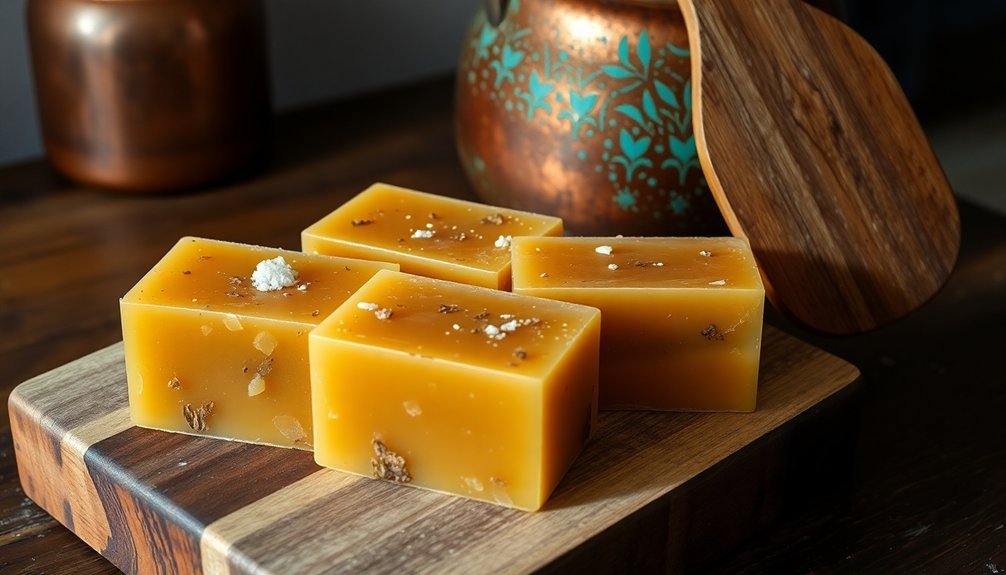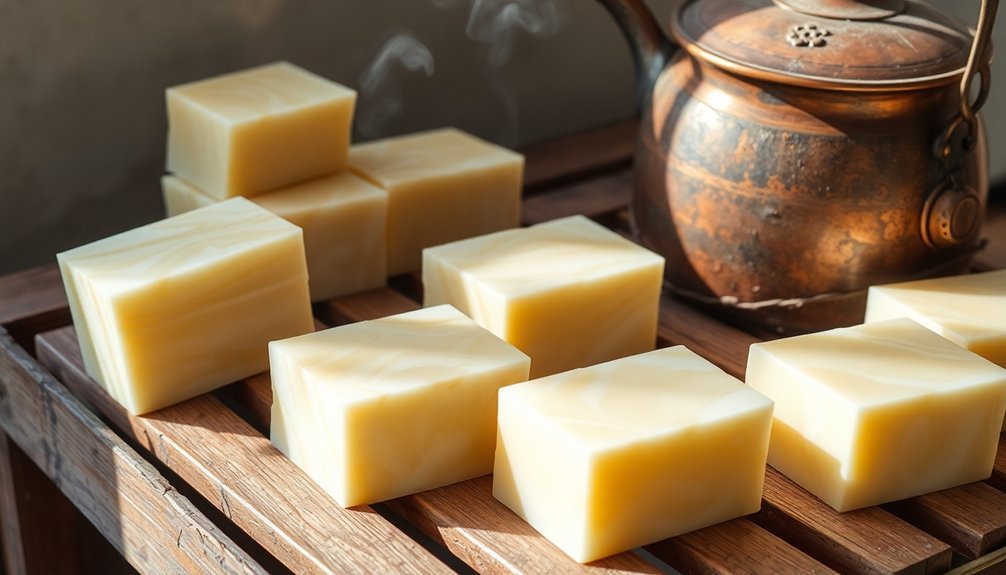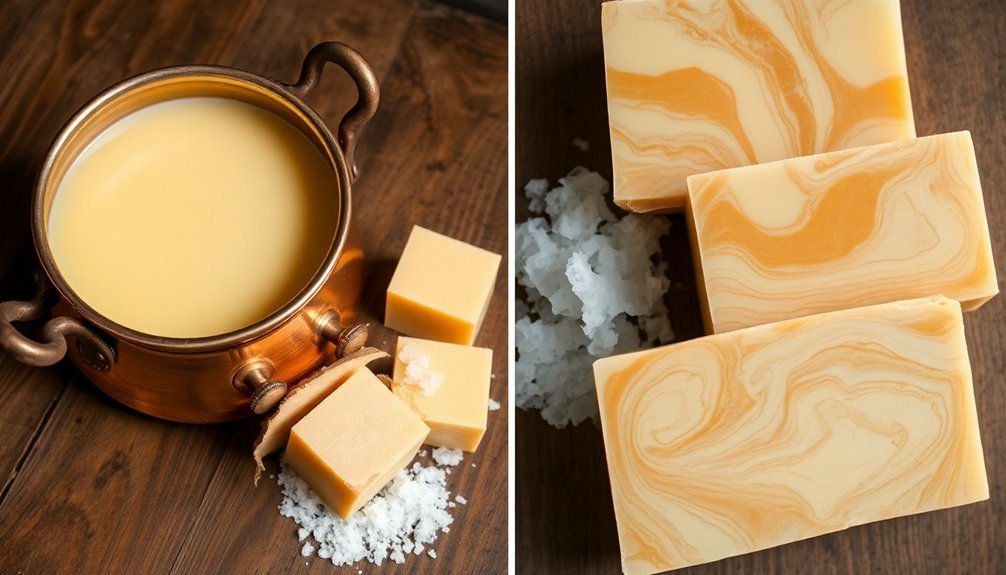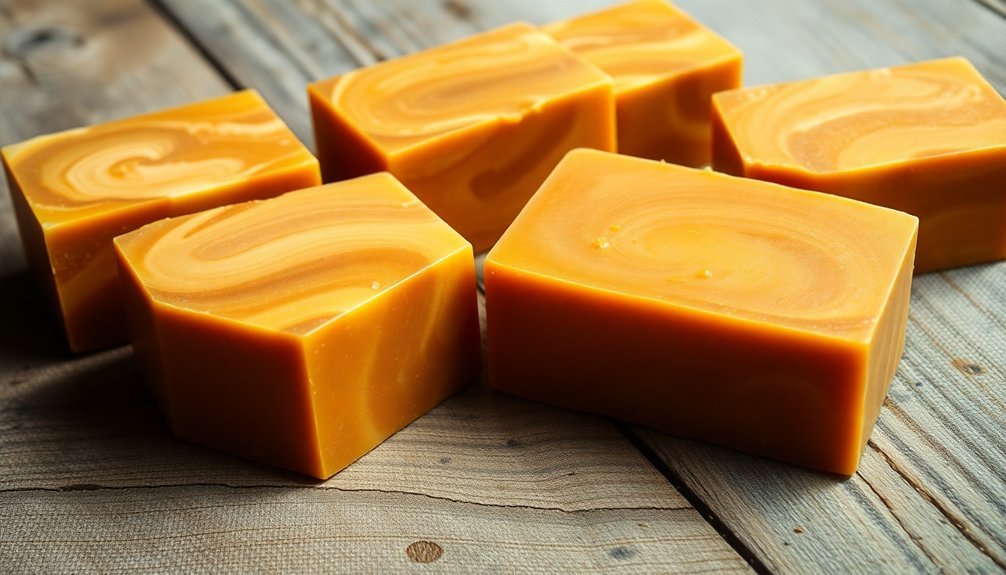You'll find old-world animal fat soaps distinctly different from modern commercial versions. These traditional soaps offer superior longevity, lasting decades while maintaining their creamy lather. They're packed with natural vitamins A, D, E, and K that nourish your skin without synthetic preservatives. The sustainable process uses local animal by-products, creating harder, longer-lasting bars. The rich history and proven benefits of these time-tested methods reveal why artisans still treasure these techniques.
Historical Origins of Animal Fat Soaps

While modern soaps line our store shelves today, the practice of making soap from animal fats traces back to ancient Rome, where women first noticed that animal fat mixed with river water created a cleansing effect. This discovery laid the foundation for centuries of soap making innovation across Europe.
Ancient Roman women pioneered soap-making when they discovered that mixing animal fats with river water produced a natural cleanser.
You'll find the historical origins of organized soap production emerged in 12th century England, where animal fat became the primary ingredient in early commercial soap making.
By the 1600s, different regions developed their own unique approaches – Spain crafted soaps from goat fat and beech ash, while France preferred olive oil for their famous Castile soap.
When hygiene advocates like Louis Pasteur emerged in the 19th century, they sparked tremendous growth in animal fat soap production, which continued until synthetic detergents took over in the 1900s.
Traditional Rendering Techniques

The time-honored art of soap making begins with proper fat rendering, a practice that evolved alongside the historical developments in soap production.
When you're working with animal fats like tallow, you'll need to heat them slowly in a large pot to separate impurities and water, ensuring the purest possible base for your soap.
This traditional process, while time-consuming, yields superior results. You'll find that properly rendered fats create a more nourishing soap through saponification with lye, retaining natural glycerin that commercial processes often remove.
The method requires minimal equipment and relies on locally sourced materials, making it both sustainable and environmentally conscious.
Unlike modern industrial practices, these old-world techniques preserve beneficial fatty acids that contribute to the soap's skin-nurturing properties.
The Chemistry Behind Tallow Saponification

Understanding tallow saponification starts with a fundamental chemical reaction between animal fat molecules and sodium hydroxide. When you combine these ingredients, the triglycerides in tallow break down and form soap molecules through esterification, creating both soap and glycerin as byproducts.
What makes tallow soap special is its high content of saturated fatty acids, particularly stearic and palmitic acids. These components give your soap bars their characteristic hardness and long-lasting quality.
You'll need to calculate the precise amount of lye using tallow's saponification value of 0.145 to achieve the perfect balance in your soap formula. The resulting product maintains a pH between 8-10, which effectively cleanses while being gentler on your skin than many synthetic alternatives.
Unique Properties of Animal Fat Bars

Traditional animal fat soaps stand apart from modern alternatives through their remarkable moisturizing capabilities and superior performance characteristics.
You'll find that animal products like tallow and lard create soaps with exceptionally creamy lather and rich, dense bubbles that nourish your skin naturally.
When you use beef tallow soap, you're getting a harder, longer-lasting bar that delivers essential vitamins A, D, E, and K directly to your skin.
The moisturizing properties of these old-world formulations are unmatched, and they don't require synthetic preservatives, making them perfect for sensitive skin.
You'll appreciate how these soaps age faster than plant-based options, getting them from production to your shower more quickly.
Plus, by choosing animal fat soaps, you're supporting sustainable practices that make use of valuable meat industry by-products.
Cultural Significance Across Centuries

You'll find that traditional animal fat soap-making methods have persisted through centuries, from ancient Roman discoveries to modern artisanal practices.
These time-honored techniques connect you to your ancestors' wisdom, particularly evident in places like Spain where goat fat and beech tree ash soaps remain a source of local pride.
The ongoing practice of making animal fat soap bridges the gap between historical necessity and cultural identity, showcasing how communities maintain their heritage through these enduring crafts.
Traditional Methods Endure
While modern manufacturing dominates today's soap industry, the time-honored practice of crafting soap from animal fats continues to captivate artisans and consumers alike.
You'll find dedicated soap makers using animal fat in methods that haven't changed much since Roman times, proving these techniques remain relevant and effective.
What's particularly fascinating is how these traditional methods have survived through generations of immigrant artisans who've preserved their cultural soap-making heritage.
Even today, you can find soap made from tallow and lard in small-batch productions, often using recipes passed down through families.
Despite the convenience of mass-produced synthetic soaps, there's a growing community of craftspeople and customers who appreciate the authentic qualities of traditionally made soap, keeping these centuries-old techniques alive and thriving.
Regional Pride Through Soap
The cultural identity of regions across Europe and beyond can be traced through their distinct soap-making traditions. You'll find that regional pride shines through in creations like Spanish goat milk soap and French Castile soap, each reflecting the unique agricultural resources of their lands.
Animal fat soap production, particularly in 17th century Spain, shows how communities maximized their local materials, creating products that became symbols of their cultural heritage.
When immigrants brought their soap-making knowledge to new shores in the 19th century, they enriched existing methods with diverse cultural influences.
Today's artisanal soap makers continue this legacy through small-batch production, honoring traditional techniques while celebrating their community's distinct identity.
Even England's delayed adoption of soap use reveals how deeply cultural norms influence the evolution of these cherished practices.
Artisanal Methods of Production
Since ancient times, artisans have crafted animal fat soap using traditional cold-process techniques that preserve the natural properties of their carefully selected ingredients.
You'll find these skilled craftspeople working in small batches, combining high-quality rendered tallow or lard through a precise saponification process with lye. They're following time-tested recipes that have been handed down through generations.
What makes these artisanal methods special is their commitment to natural practices. You won't find synthetic additives or preservatives in these soaps – instead, you'll discover pure ingredients that create hard, long-lasting bars with superior lathering qualities.
The process allows artisans to customize each batch with unique scents and beneficial herbs while maintaining the soap's moisturizing properties. It's this dedication to traditional craftsmanship that sets old-world animal fat soap apart.
Quality Indicators and Testing
You'll notice quality old-world animal fat soaps develop distinctive physical traits during curing, including a translucent sheen and firm texture that won't yield to gentle thumb pressure.
To test the soap's readiness, you can evaluate its lather characteristics, with properly cured tallow and lard soaps producing rich, stable bubbles that indicate complete saponification.
When examining cold process curing signs, you should look for consistent color throughout the bar, minimal moisture content, and a pH level between 8-10, confirming the soap's readiness for use.
Physical Changes Over Time
When examining old-world animal fat soap, several physical changes indicate its quality and usefulness over time.
You'll notice that tallow soaps and those containing lard in soap maintain their structure remarkably well, often lasting over six decades without deteriorating. Their creamy lather remains consistent throughout their lifespan, showcasing the enduring quality of traditional soap-making methods.
As your soap ages, you'll observe these distinctive characteristics:
- The bar becomes harder and more resistant to becoming mushy when wet, unlike modern synthetic alternatives.
- The lather maintains its signature small bubbles with lard-based soaps, while tallow creates larger, stable bubbles.
- Natural vitamins A, D, E, and K continue to provide skin-nourishing benefits, even after extended periods of storage.
These physical properties demonstrate why old-world soap-making techniques have stood the test of time.
Lather and Cleansing Tests
Testing the quality of old-world animal fat soaps involves examining both their lather characteristics and cleansing effectiveness.
You'll notice that soaps made with tallow or lard create a distinctively dense, creamy lather that sets them apart from modern synthetic alternatives.
When you test these animal fat soaps, you'll find they produce larger bubbles that efficiently lift dirt and impurities from your skin.
What's particularly remarkable is their gentle cleansing action – they won't leave your skin feeling stripped or dry. Instead, the natural fatty acids and vitamins in the animal fats help maintain your skin's moisture balance.
High-lard soaps cure faster, typically within three weeks, while tallow-based varieties need more aging time but reward you with exceptional durability.
Users consistently report softer, more hydrated skin after using these traditional cleansers.
Cold Process Curing Signs
During the crucial 4-6 week curing period, cold process animal fat soaps reveal distinct signs that indicate their readiness for use.
You'll notice several physical and chemical changes that confirm proper curing has occurred.
Key indicators of well-cured animal fat soaps include:
- A firm, solid texture when pressed, showing that excess moisture has evaporated
- A pH level between 7-10, which you can verify using test strips to guarantee skin safety
- A smooth, creamy lather characteristic of properly cured tallow or lard-based soaps
As your cold process soaps age, you might observe slight changes in color or scent – these are normal signs of maturation.
These natural variations demonstrate that your animal fat soaps have developed the desired qualities through proper curing, making them ready for a superior washing experience.
Regional Variations and Recipes
Throughout history, each region developed its own distinctive approach to animal fat soap making based on locally available ingredients and cultural traditions. You'll find that French soap makers favored olive oil in their Castile soaps, while Spanish artisans combined goat fat with beech tree ashes. These regional variations created unique properties in texture, hardness, and moisturizing abilities.
| Region | Traditional Ingredients |
|---|---|
| France | Olive oil, local ashes |
| Spain | Goat fat, beech ashes |
| England | Lard, tallow blends |
| America | Mixed animal fats, wood ashes |
| Mediterranean | Olive oil, marine plant ashes |
During the 17th century, soap makers carefully crafted their recipes using specific ratios of local fats and ashes. When you examine these old-world techniques, you'll notice longer aging times were common, particularly when working with tallow-based formulations.
Storage and Aging Practices
While plant-based soaps often require months to fully cure, traditional animal fat soaps reach maturity in just three weeks – a key advantage for historical soap makers.
The aging process creates a harder bar that's less likely to absorb moisture, helping extend its shelf life.
You'll need to follow specific storage practices to maintain your animal fat soap's quality:
- Keep your soaps in a cool, dark place to prevent the fats from turning rancid
- Wrap them in breathable materials like paper or cloth to allow proper air circulation
- Avoid plastic wrapping, which can trap moisture and compromise the soap's integrity
Unlike modern alternatives, these traditional soaps don't rely on synthetic preservatives.
Instead, they depend on proper storage conditions and their natural composition to maintain their quality and effectiveness over time.
Benefits for Skin Health
Your skin will receive deep nourishment from the essential vitamins A, D, E, and K found naturally in old-world animal fat soaps.
These traditional soaps strengthen your skin's protective barrier while providing superior moisturizing benefits without harsh chemicals or synthetic additives.
You'll notice how the vitamin-rich natural fats work to hydrate and protect your skin, making it healthier and more resilient over time.
Deep Natural Skin Nourishment
Natural skin nourishment reaches new depths with old-world animal fat soaps. When you use traditional soaps made from beef tallow, you'll experience a level of skin nourishment that modern alternatives can't match.
These animal fat soaps deliver essential vitamins A, D, E, and K directly to your skin, promoting better health and hydration.
Your skin will benefit from these key features:
- Natural fatty acids that restore and strengthen your skin's protective barrier
- Long-lasting formulation that doesn't require artificial preservatives
- Gentle cleansing that maintains your skin's natural oil balance
You'll notice improved texture and reduced irritation as these soaps work to deeply moisturize your skin. The pure, time-tested ingredients provide lasting benefits without harsh chemicals, making them especially suitable for sensitive skin types.
Enhanced Barrier Protection Benefits
Traditional animal fat soaps create a powerful defensive shield for your skin by forming a protective lipid barrier that locks in essential moisture. When you use soaps made from beef tallow, you'll benefit from their rich content of vitamins A, D, E, and K, which strengthen your skin's natural defenses against environmental damage.
These soaps help prevent water loss while nourishing your skin with essential fatty acids. Unlike modern products loaded with synthetic additives, old-world animal fat soaps maintain skin hydration through their naturally occurring glycerin, which draws moisture into your skin.
The solid, long-lasting structure of these soaps guarantees consistent protection without deteriorating quickly. Your skin receives gentle, effective cleansing while maintaining its protective barrier, making these soaps particularly beneficial for those with sensitive skin.
Vitamin-Rich Moisturizing Properties
While many modern soaps strip away essential nutrients, old-world animal fat soaps deliver a potent blend of vitamins A, D, E, and K directly to your skin.
These vitamin-rich formulations work naturally with your body's chemistry, providing deep moisturizing properties that synthetic alternatives simply can't match.
When you use animal fat soap, you'll experience benefits that go beyond basic cleansing:
- The natural fatty acids enhance your skin's elasticity and help repair damaged tissue
- Your skin retains its natural moisture barrier while receiving nourishing vitamins
- The gentle cleansing action keeps your skin hydrated without harsh preservatives
The unique combination of moisturizing properties and essential vitamins makes these traditional soaps particularly effective for sensitive skin types, helping you maintain a healthy, radiant complexion while avoiding the drying effects of synthetic detergents.
Sustainability and Waste Reduction
Making soap from animal fats represents a cornerstone of sustainable manufacturing, as it transforms meat industry by-products into valuable personal care items. When you choose old-world animal fat soap, you're participating in a zero-waste philosophy that reduces environmental impact by repurposing materials that might otherwise end up in landfills.
| Sustainability Benefits | Waste Reduction Impact | Environmental Value |
|---|---|---|
| Reuses by-products | Less landfill waste | Lower carbon footprint |
| Supports local economy | Reduces synthetic use | Natural resource preservation |
| Circular production | Maximizes animal use | Minimal processing needed |
| Traditional methods | Zero-waste approach | Petrochemical alternative |
This traditional approach to soap making demonstrates how historical practices can offer modern solutions for sustainability, connecting you to time-tested methods that support both environmental responsibility and effective personal care.
Modern Applications of Ancient Methods
Modern soap makers have rediscovered the timeless wisdom of old-world animal fat soap production, adapting historical techniques for contemporary manufacturing. You'll find artisans using tallow and traditional saponification methods to create eco-friendly soaps that deliver superior skin benefits without synthetic additives.
Today's producers embrace these ancient methods because they're both efficient and effective:
- Animal fat soaps require less aging time than plant-based alternatives, speeding up production while maintaining quality.
- Natural vitamins A, D, E, and K are preserved through traditional processing methods.
- The process supports sustainability by utilizing byproducts from the meat industry.
You're getting more than just soap when you choose these traditional products – you're participating in a revival of time-tested craftsmanship that combines historical knowledge with modern environmental consciousness.
Preserving Heritage Techniques
Artisans dedicated to preserving old-world soap-making traditions understand that each batch tells a story of cultural heritage. When you explore these time-honored methods, you'll discover how preserving heritage techniques connects you to centuries of craftsmanship and regional identity.
You'll find that traditional animal fat soap production emphasizes the sustainable use of resources, transforming what might otherwise be waste into valuable skincare products. These methods have been carefully passed down through generations, with each region maintaining its unique recipes and processes.
Today's artisans honor these practices through small-batch production, ensuring the authenticity and quality that mass-produced soaps can't match. By supporting these traditional methods, you're not just choosing a superior product – you're helping to keep alive the cultural wisdom and ecological responsibility embedded in these ancient techniques.
Frequently Asked Questions
Is Animal Fat Soap Better?
You'll find animal fat soap offers superior benefits like natural vitamins, better moisturizing, and longer-lasting bars. It's gentler on your skin and creates richer lather compared to synthetic alternatives while supporting sustainable practices.
What Are the Disadvantages of Tallow Soap?
You'll find tallow soap has several drawbacks: it creates thinner lather, requires longer curing time, can be too hard, and might conflict with your ethical views. It's also challenging to source consistently quality tallow.
What Was Old Soap Made Of?
You'll find that old soap was primarily made from animal fats like tallow and lard, combined with plant ash lye. They'd also use local ingredients like olive oil, goat fat, and beech ashes for soap-making.
What Is the Main Difference Between Soap Made From Animal Fat Versus Vegetable Oil?
You'll find that animal fat soaps are harder and last longer than vegetable oil soaps. They create a creamier lather with bigger bubbles, and they're packed with natural glycerin and skin-nourishing vitamins A, D, E, and K.
In Summary
You'll find that old-world animal fat soaps carry forward a rich legacy of sustainability and proven effectiveness. They've stood the test of time because of their superior moisturizing properties and minimal waste production. Whether you're interested in traditional craftsmanship or seeking natural skincare alternatives, these heritage soaps offer benefits that modern commercial products can't match. Their time-tested methods continue to influence artisanal soapmaking today.





Leave a Reply